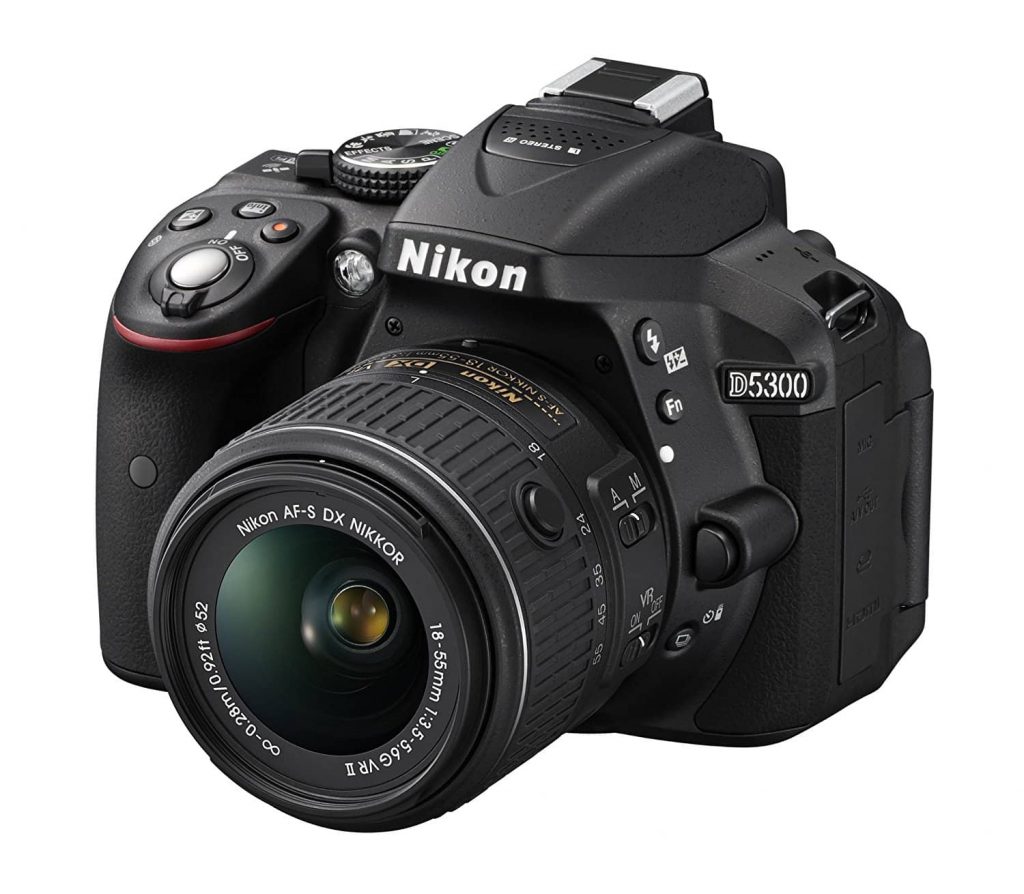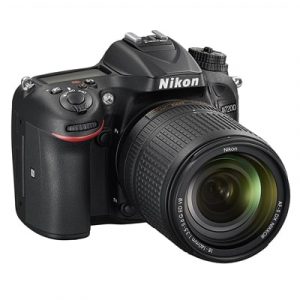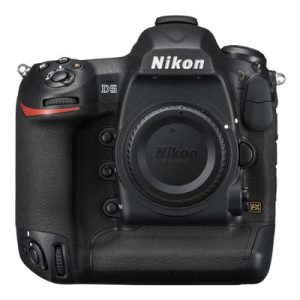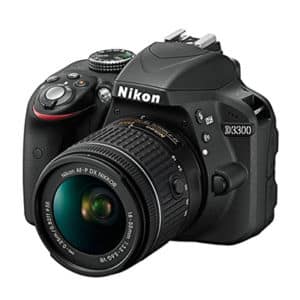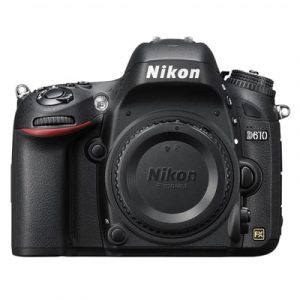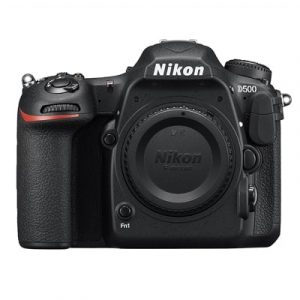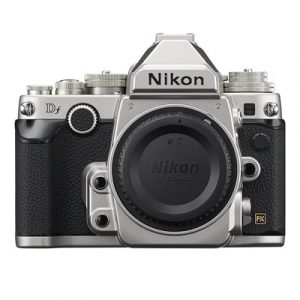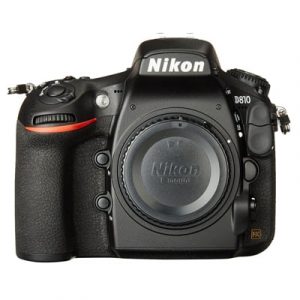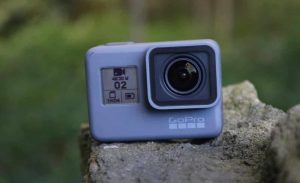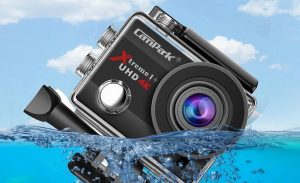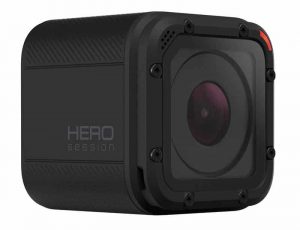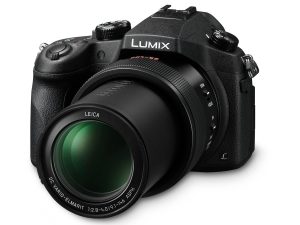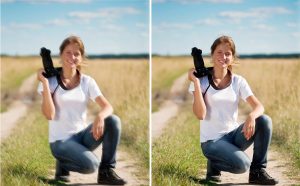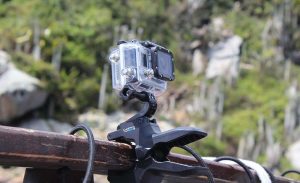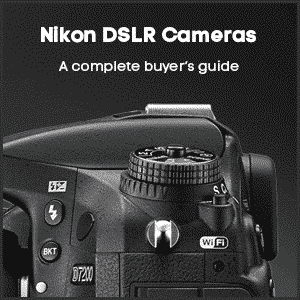
But I’m sure you’ll agree with me when I say it can be tough to make a decision on which Nikon camera to buy.
There are 15 cameras in the Nikon range, and while it’s reasonably straight forward to separate the entry-level cameras from the pro models, it gets a little tougher to work out which camera is the best in each range.
So to help you make your decision, we’ve gone in-depth into Nikon’s DSLR range and compared and contrasted the features of ALL their cameras.
We’ll give you all the information you need to make an informed decision on which Nikon DSLR camera is right for you.
There’s a lot detail in this ultimate Nikon camera comparison, so if you already know which level you’re looking for, then you can jump to that section.
Otherwise, let’s get started!
Jump To Section
Best Entry Level Nikon DSLRs
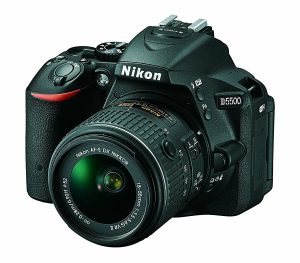
While we could argue about what it is exactly that makes a DSLR ‘entry-level’, we’ll keep things simple and run with what Nikon consider to be their beginner DSLRs.
There are currently 5 of them:
The D3300, the D3400 (which is an upgrade to the 3300), the D5500, the D5600 (yes, that’s an upgraded 5500), and the D5300.
So let’s take a look at the specs.
| D3300 | D3400 | D5300 | D5500 | D5600 | |
|---|---|---|---|---|---|
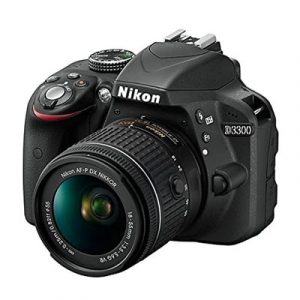 | 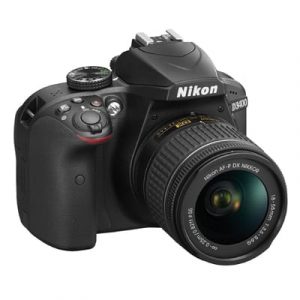 | 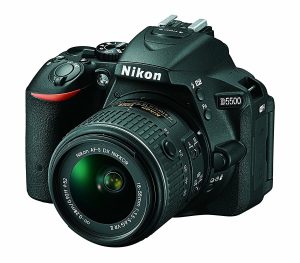 | 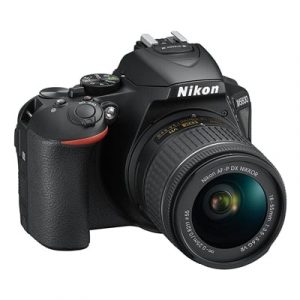 |  |
|
| Image Processor | EXPEED 4 | EXPEED 4 | EXPEED 4 | EXPEED 4 | EXPEED 4 |
| Sensor Format | APS-C | APS-C | APS-C | APS-C | APS-C |
| Sensor Type | CMOS | CMOS | CMOS | CMOS | CMOS |
| Megapixels | 24.2 | 24.2 | 24.1 | 24.1 | 24.2 |
| Focus Points | 11 | 11 | 39 | 39 | 39 |
| ISO Range | 100-12800 | 100-25600 | 100-12800 | 100-25600 | 100-25600 |
| Display Size | 3" | 3" | 3.2" | 3.2" | 3.2" |
| Touch Screen | No | No | No | Articulated | Articulated |
| Live View | Yes | Yes | Yes | Yes | yes |
| Movie Mode | Yes | Yes | Yes | Yes | Yes |
| Max FPS | 5 | 5 | 5 | 5 | 5 |
| Weight (g) | 430 | 395 | 480 | 420 | 415 |
| Dimensions | 124 x 98 x 76 | 124 x 98 x 76 | 125 × 98 × 76 | 124 × 97 × 70 | 124 x 97 x 70 |
| Video Resolution | 1080p / 60fps | 1080p / 60fps | 1080p / 60fps | 1080p / 60fps | 1080p / 60fps |
| Release Date | 2014 | 2016 | 2013 | 2015 | 2016 |
| Wi-Fi | No | No | Yes | Yes | Yes |
| Bluetooth | No | Yes | No | No | Yes |
As you can see, there’s not a lot between the cameras when it comes to specs. They all have pretty much the same sensor, with the same number of effective pixels.
Where the D5xxx cameras trump the D3xxx cameras is pretty much auto-focus (much better) and audio recording.
With regards to the later, all the D5xxx cameras have built in stereo mics + the ability to plug in an external stereo mic. Oddly, the D3300 allows you to plug in a mic, while the newer (and more expensive) D3400 doesn’t. Why Nikon?
So you’ll get a bit more camera in the D5xxx range, but you’ll also (naturally) pay a bit more. Let’s do a couple of quick head to heads.
Nikon D3300 vs Nikon D3400
Where the D3300 beats the D3400
- External mic input
- More powerful flash
- Cheaper
Where the D3400 beats the D3300
- Higher native ISO range of 25600
- Built-in Bluetooth
- Longer battery life
- Newer model
- Lighter
Let me start by saying that we were big fans of the D3300. Indeed, we’ve consistently recommended it to those looking to buy their first DSLR.
But technology marches on, and the D3400 is an improvement on the D3300. Even if that improvement is more evolution than revolution.
Let’s look at where the D3400 beats the D3300:
ISO Sensitivity
The D3400 increases max ISO from 12800 to 25600.
Maximum ISO refers to the ability of the camera sensor to produce ‘reasonably’ clean images at low light without having to change the exposure value.
The D3400 would be able to to produce images at about half the light value as the D3300 is capable of (at the lower end), without requiring you to tinker with the exposure values.
Having said that, at ISO 25600, you are going to have to deal with a significant amount of noise. So, for all practical purposes the D3400’s higher ISO level isn’t that big of an advantage.
Connectivity
This is where the Nikon D3400 definitely picks up some brownie points.
While there was no in-built connectivity on the D3300, the D3400 includes built-in Bluetooth connectivity. You can use Bluetooth to control your camera via a compatible smartphone / tablet.
Sadly, however, there is still no built-in Wi-Fi. Wi-Fi on both cameras can be used only by plugging in the optional Wu-1a adapter.
Battery Life
Nikon claim you’ll get about 1200 shots out of the D3400 on a full charge, compared to just 700 for the D3300. So that’s another win.
The difference is probably because of the new flash. It consumes less power compared to the one on the D3300 and also has a shorter effective range (7 meters compared to 10 on the older camera). So, you get a less powerful flash but get to shoot more images.
For all practical reasons, using the built in flash isn’t always a great idea. You might use it for filling in the shadows, or to compensate for harsh color cast and certainly when shooting in low light (to avoid image blur), but for the major part, light from the built in flash produces flat boring images.
Weight
The 3400 is a slightly lighter camera compared to the D3300. Not too much though, just about 70 grams.
So where does the Nikon D3300 beat the D3400?
Well, I already mentioned it above. For some reason Nikon removed the stereo mic jack on the D3400. While that might not be a dealbreaker for some, for others you won’t be able to take advantage of an external mic in case you are looking to shoot videos.
Is the D3300 a better camera compared to the D3400? No. If Bluetooth is your life-force and or you can’t live without firing the flash every time you press the shutter release, then the D3400 is a good choice for you. But if you are a photographer looking for a good camera and prefer to put the rest of your money on a good lens, then go for the D3300. If you already own the D3300, you have no reason to feel bad.
Now let’s look at the D5xxx range.
Our two favourites are the D5500 and the D5600, so let’s see which one is the best.
Nikon D5500 vs D5600
Where the D5600 beats the D5500
- Newer model
- Built in bluetooth
- NFC connectivity
- Cull images in playback mode
- Built in time-lapse feature
Ok, I’m not going to beat about the bush here. Most of the specs are exactly the same.
Both cameras have the same size sensor, with neither having an anti-alias filter. That’s generally a good thing, as it will increase the sharpness of your images. There is, however, one downside to increased sharpness. When photographing fabric fine repetitive patterns you are likely going to pick up some moire and false colors.
So really what we’re looking at here is connectivity and a few other aspects.
Both cameras have built in Wi-Fi, but the D5600 also has bluetooth, something that the D5500 doesn’t. Plus, you also get NFC connectivity with the D5500. In as much as connectivity is concerned the D5500 is definitely the superior of the two cameras.
Another addition to the D5600 is the ability to cull images while reviewing them in playback mode. This you can achieve using the touchscreen functionalities. This saves you from the extra time that is required to first download the images to a computer and then cull them as necessary.
Additionally, the D5600 has a built in time-lapse feature. If you are a big time-lapse fan you’d no doubt love this one. After your time-lapse sequences are shot the camera can automatically format the images and stitch them together to prepare a time-lapse footage.
Feature-wise there are no further differences between the two cameras and that makes the D5600 a superior camera compared to the D5500.
Which Is The Best Entry Level Nikon DSLR?
Well, it’s between the D3400 and the D5500 for us. So let’s see which camera wins.
Nikon D3400 vs D5600
Where the D5600 beats the D3400
- Articulated screen
- Touch screen control
- Built-in Wi-FI
- Built-in Bluetooth
- NFC
- Higher native ISO range of 25600
- More autofocus points (39)
- Built-in time-lapse integration feature
- Built-in image culling feature
So, it really comes down to how much you want to spend. Even then the D5600 is in a different league compared to the D3400. Sure, they both make good images. Essentially, they use the same sensor and the same image processor, but the D5600 packs in more features compared to the D3400.
If you can afford the extra £100 or so, then go for the D5600 – it’s definitely a better camera. But if not, the D3400 won’t let you down.
But as we have to pick a winner, we’re going to say the Nikon D5600 is the best entry level Nikon DSLR camera.
Best Enthusiast Level Nikon DSLRs
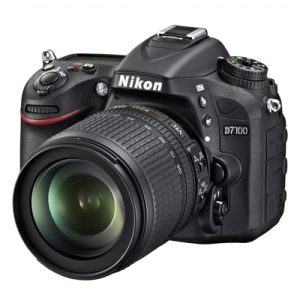
There are currently 3 models on offer. These are the D7100, the D7200 and the D610.
The D7200 is an upgrade of the very popular D7100. These are crop sensor (APS-C) cameras with semi-pro grade build quality and dual command dials.
The other option in this category is the D610. This is a full-frame (35mm) camera and an upgrade of the original D600, the cheapest full-frame DSLR that Nikon has on offer.
Let’s pit the cameras against each other and find out which one is the better of the three.
Nikon D7100 vs D7200
Mid range and entry level cameras from Nikon have been dropping the optical low pass filter like a bad habit for the past few years.
While it was certainly improved the image sharpness and amount of detail captured by the new high resolution sensors, some amount of false colors and moire is inevitable.
With that in mind both the D7100 and the D7200 are equally matched. Though on paper the D7200 is an improved version of the D7100, at least that’s what it is supposed to be.
Where the D7200 beats the D7100
- Newer model
- Built in Wi-FI
- NFC connectivity
- EXPEED 4 image processor
- Higher native ISO range
- Better dynamic range in low light
- Increased buffer capacity
- Full HD (progressive)
Connectivity
The most significant difference between the D7200 and the D7100 is connectivity. The D7200 has built-in Wi-Fi, along with NFC. The older camera doesn’t have those.
Image Processing
The D7100 has the older generation EXPEED 3 image processor. The D7200 gets the new generation EXPEED 4 image processor. This improves continuous shooting, low light performance and buffer handling.
ISO Sensitivity
Native ISO sensitivity is another aspect where the D7200 beats the older D7100. The older D7100 had a native ISO range of 100 – 6400. That has been upgraded on the D7200 to 25600. Between the two cameras the D7200 tend to produce ‘cleaner’ low light images with less amount of noise. Noise in low light is a bane for photographers looking to capture detail.The D7200 seems to be ahead in that respect. Though I have to add that neither camera qualifies for the tag of ISO invariance. Additionally, the D7200 produces better dynamic range in low light.
Buffer Capacity
The D7200 is definitely a better camera when it comes to buffer capacity. Nikon claims that the buffer of the D7200 is capable of capturing up to 100 JPEG shots. Those who have shared their feedback having used both the cameras side by side swear by the D7200’s improved buffer capabilities and the ability to handle long bursts of continuous shooting.
If you are shooting RAW you can hope to capture up to 18 lossless 14-bit frames with the D7200 (compared to about 6 with the older D7100).
Low Light Performance
Low light performance of the D7200 is definitely better compared to the D7100. The D7100 often loses focus lock when shooting in low light and when trying to focus on fast moving subjects. The D7200’s autofocusing performance is much better in low light.
Movie Shooting
While most features are the same between the two cameras, what matters is that the D7200 can shoot full-HD in 1080p (progressive) as against full-HD 1080i (Interlaced) with the D7100.
Nikon D7200 vs D610
The D610 is a full-frame camera and that is its biggest USP. Size does matter, at least when it comes to photography. A larger sensor means more light gathering surface, better signal to noise-ratio, in other words cleaner images, shallower depth of field and the ability to make full use of Nikkor’s FX lenses. The D610 is the second in the D6xx line-up and one that improves on the original D600.
Where the D7200 beats the D610
- Cheaper compared to the D610
- Advanced autofocusing system with more cross-type AF points
- NFC and Wi-Fi connectivity
- Effective focal length of telephoto lenses become longer
- Has no anti-aliasing filter
- Higher resolution rear LCD screen
Where the D610 beats the D7200
- Larger sensor and more light gathering abilities.
- Shallower depth of field
- Better DXoMark score
Sensor
Apart from the fact that it is a full-frame camera it has a slightly more resolution compared to the D7200. Even if it is just. 24.3 effective megapixels compared to 24.2 on the D7200. The D610 has an anti-aliasing filter (OLPF) but the D7200 does not (as has been mentioned above). That should result in sharper imagery with the D7200 compared to the D610. Thus, for landscapes, birding etc., the D7200 is the better choice. For portraits, headshots, low light and weddings the D610 is the better choice.
An important point to be noted is the recent DXoMark rating for these two cameras. The D610, being a full-frame, gets a 94 rating. Compare that to the D7200 which gets a rating of 87. Very close to breach the 90 point mark that most full-frame cameras tend to enjoy. This might be a good reference point when making the buying decision.
Having said that, the D7200 being a small sensor camera has the better deal
Image Processing
The D7200 is powered by the new EXPEED 4 image processor, compared to the EXPEED 3 image processor on the D610.
Connectivity
The D7200 being a new generation camera has the better connectivity features. It has built in Wi-Fi and NFC. The D610 in comparison is Wi-Fi ready. Meaning you can plug-in the optional WU-1b wireless adapter in order to wireless connect to an available wireless network.
AF Points
The D610 has a 39-point AF system, 9 out of those are cross-type. Compared this to the D7200’s 51-point autofocusing system which is a much more improved system.
ISO Sensitivity
Native ISO sensitivity on the D7200 has already been detailed above. The D610 has a native ISO range of 100 – 6400. Theoretically, at least, the D610 is less sensitive than the D7200. But then shooting at high ISO has to be backed up with excellent noise-cancelling properties.
Connectivity
The rear LCD screen on the older D610 has a resolution of 921k-dots. Compared to that the new D7200 has a resolution of 1229k-dots. Plus the D7200’s LCD has an anti-reflective coating which makes it easier to see under bright sunny conditions
Between the D610 and the D7200, it comes down to the question whether you are looking for the cheapest Nikon full-frame you can lay your hands on or one of the best DX camera that Nikon has to offer.
Which Is The Best Enthusiast Level Nikon DSLR?
If the question is not about sensor alone, then the D7200 beats its full-frame rival quite comfortably.
Pro Level Nikon DSLRs
Nikon’s Pro-grade cameras are mainly about what they have to offer in full-frame sensors.
Along with the larger sensor these cameras also have better build quality, faster continuous shooting speed and better autofocusing. Some of these cameras such as the Nikon DF are true low light champions.
This segment include the following cameras –
The Nikon D5, which is the replacement for the hugely popular Nikon D4, the D810 and its astronomy photography avatar the D810A, the D750 and of course the DF. We also have the recently recently released D500. This is the lone DX format camera that made it to the Pro level segment.
There is little difference between the D810 and the D810A, except that the later comes with a special infrared cut filter that makes it four times more sensitive to the H-alpha spectral line. Thus, we are not taking the D810A into the next one to one fight.
Nikon D5 v D500
Both the D5 and the D500 have been designed to shoot sports, action and low light photography. Despite the difference in sensor sizes, there is an obvious similarity between the two cameras in that respect. Faster continuous shooting speed ensures that these high speed action photos are conveniently shot with these cameras.
Better low light photography performance even when shooting at a high ISO number, better built in Noise Reduction features and better D-lighting ensures you can shoot in JPEG more consistently than with other cameras, even when shooting in low light conditions.
Where the D5 beats the D500
- Larger full-frame sensor
- Faster continuous shooting speed of 12 fps against 10 fp on the D500
- Comes with a built in battery grip complete with a shutter button and a set of command dials
- Higher native ISO range 100 – 102400
- Better build quality with full weather sealing
- The D5 has a slightly better shutter design with longer promised life
- Bigger viewfinder
Where the D500 beats the D5
- Lighter than the D5 making sure long shooting sojourns are easier on your forearms
- Larger resolution 20.9 megapixels against 20.8 on the D5
- Articulating rear LCD screen
- Focusing points on the viewfinder appears to cover the whole of the frame.
- Way cheaper than the D5
Buffer Capacity
The D5 and the D500 share a special bond. They are the fastest cameras in their respective sensor formats. The D5 has a continuous shooting speed of 12 fps. Correspondingly the D500 has a continuous shooting speed of 10 fps.
ISO Sensitivity
Native ISO sensitivity on the D500 is 100 – 51200. The same on the D5 is 100 – 102400.
Connectivity
This is where probably the D500 beats the D5 comprehensively. The D5 does not have as many connectivity options as the D500. The later has built in Wi-Fi, NFC and Bluetooth connectivity.
Rear LCD Screen
The rear LCD screen on the D500 and the D5 are the same. They are both 3.2” in size and have the same resolution of 2359,000 dots. Both come with very effective touchscreen functionality. The only difference being the one on the D500 is articulating and the one on the D5 is non-articulating.
AF Points
Both cameras share the same autofocusing mechanism. A Multi-CAM 20K AF sensor with TTL phase detection. Both systems have the same 153-point AF mechanism with 99 cross-type AF sensors. 15 sensors support up to f/8.
Both cameras have the same fast shutter speed of 1/8000 sec.
If you are looking for a scaled down DX version of the D5 or even the D810 then the D500 is the camera you had been waiting for. Don’t need to look beyond it. Having said that, if full-frame is the segment that you are looking to get into along with superior autofocusing, low light performance and build quality, then you need the D5. Which one is the better camera among the two? All things concerned it is the D5.
Nikon DF vs D810
The Nikon D810 and the Nikon DF are two vastly different cameras. The D810 is an upgrade of the very popular D800 and the D800E and combines the best of these two cameras. The Nikon DF on the other hand is an honest attempt at reviving the film camera design of yesteryears and combining a retro design with a powerful full-frame sensor and a versatile lens mount.
Where the DF beats the D810
- Definitely the better of the two cameras when it comes to low light shooting
- Thinner profile than the D810
- The ability to mount legacy (AI and non-AI) F mount lenses which would be impossible for any other Nikon DSLR.
- 5.5 fps continuous shooting speed compared to 5 on the D810
- Lighter than the D810
- Rugged film camera styling with mechanical exposure control dials
- Slightly more battery life allowing the DF to shoot about 200 extra shots on a full charge
Where the D810 beats the DF
- Shoots full HD videos with continuous autofocusing
- More megapixels, means greater resolution
- More AF points
- No OLPF which means the sensor is likely be able to pick up a greater amount of detail compared to the sensor on the DF.
Image Sensor
The DF and the D810 are both full-frame cameras but they have a lot of difference in resolution. The sensor on the D810 has an effective megapixel of 36.3, whereas the DF has an effective megapixel of 16.2.
Image Processing
Furthermore, the DF is powered by the older EXPEED 3 image processing engine whereas the D810 has the latest EXPEED 4 image processing engine.
Auto-focusing Point
Furthermore, the D810 has more AF points compared to the DF. The D810 has a Multi-CAM 3500 FX 51-point AF system. Compared to this the DF has a Multi-CAM 4800 39-point AF system.
ISO Sensitivity
The D810 and the DF are both very capable shooters in low light situations. However, the DF is the better shooter among the two when you go past ISO 6400.
Movie Shooting
The DF does not shoot videos. Not even 720p HD. That should immediately drop it from the prospect list of new digital camera buyers. The D810 shoots full-HD (1080p) videos.
Needless to say, the D810 is the more complete camera of the two.
The DF is a film camera at heart. It makes no attempt at hiding the fact that Nikon made this for film buffs, looking to explore digital photography and wanting to see their legacy Nikkor lenses see action again. It has a good build quality, fantastic handling and great low light image quality.
On the other hand the D810 is a true versatile digital camera. It shoots great stills, fantastic videos, has a great low light image quality (loses out by a little margin to the DF), greater sensor resolution and better AF system.
At the end it all comes down to the type of photographer you are. For someone who wants to explore Nikkor’s legacy lenses then the choice is obviously the DF. For someone who is looking for a better all round camera the choice is D810. Overall the D810 is slightly ahead.
Nikon D5 v D810
We have already seen these two cameras pitted against other cameras in the pro-section.The D5 is undoubtedly the best sports and action camera from the Nikon stable. It is the current flagship full-frame pro DSLR from Nikon. On the other hand, the D810 is the latest evolution of the D8xx series. It is a great camera in its own rights.
Where the D5 beats the D810
- EXPEED 5 image processing engine compared to the older EXPEED 4 on the D810
- 12 fps continuous shooting speed. The ideal camera for sports and action.
- Better autofocusing mechanism
- Better video shooter with 4K UHD capability
- Higher resolution rear LCD screen with touchscreen functionality
Where the D810 beats the D5
- 36.3 megapixels compared to 20.8 megapixels on the D5
- No optical low pass filter which ensures a greater amount of detail for images shot with the D810
Image Sensor
The D810 comes with a 36.3 megapixel sensor, with no OLPF. It is designed for the sole purpose of capturing detail, lots of it. On the other hand the D5 despite being a full-frame camera comes with a resolution of 20.8 megapixel.
Image Processing
The D5 comes with the latest EXPEED 5 image processing engine. The D810 comes with the older EXPEED 4 image processor.
Auto-focusing Points
Another advantage of the D5 is its faster and more capable autofocusing mechanism. It has a Multi-CAM 20K 153-point AF system. 99 of which are cross-type sensors. Comparatively, the D810 has a Multi-CAM 3500FX 51-point AF sensor. 15 of which are cross-type.
Continuous Shooting speed
The D5 is built for fast action and sports and those sort of challenges where other cameras tend to stutter and fail miserably. The snappy autofocusing is a joy to work with in low light. Add to that the fast continuous shooting speed. The D5 shoots at a phenomenal 12 fps compared to the D810 which shoots at only 5fps.
Movie Shooting
The D5 is the better of the two cameras when it comes to video shooting as well. It shoots 4K UHD videos at a framerate of 30fps. Comparatively, the D810 shoots only full HD videos and at a maximum framerate of 60fps. Both cameras can record stereo sound using built in stereo mics and have the ability to plug in an external stereo mic for better sound quality.
Rear LCD Screen
The rear LCD screen of the D5 has a resolution of 2.36 million dots and has touchscreen functionality. Comparatively, the resolution on the D810 is 1229k-dots. While neither would be the preferred choice for image reviewing or culling, a brighter and sharper resolution lets you check and confirm if the image you just captured is sharp enough.
Weather Sealing
The D5 is definitely the all weather sealed body of the two. Though, the D810 is pretty well-built as well. However, when you are heading towards inclement weather and need something that can withstand almost everything Mother Nature can throw at you, the D5 is the camera you need.
The D5 is the better of the two cameras when we compare the autofocusing prowess, still and video shooting capabilities. It is no doubt faster, more accurate in fast action mode and produces better video quality than the D810. But the D810 is the better of the two when it comes to still resolution.
Which Is The Best Pro Level Nikon DSLR?
Over all none of the pro segment cameras come with a complete list of features that one might want. There is no single camera that could claim to be the best in all areas. You have to make a check-list of the features you need and accordingly find the camera that meets all of them or at least a majority of them.
In that respect, the D810 is the overall winner, the camera with the best overall list of features.
